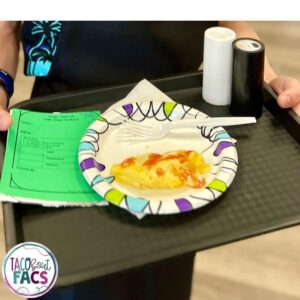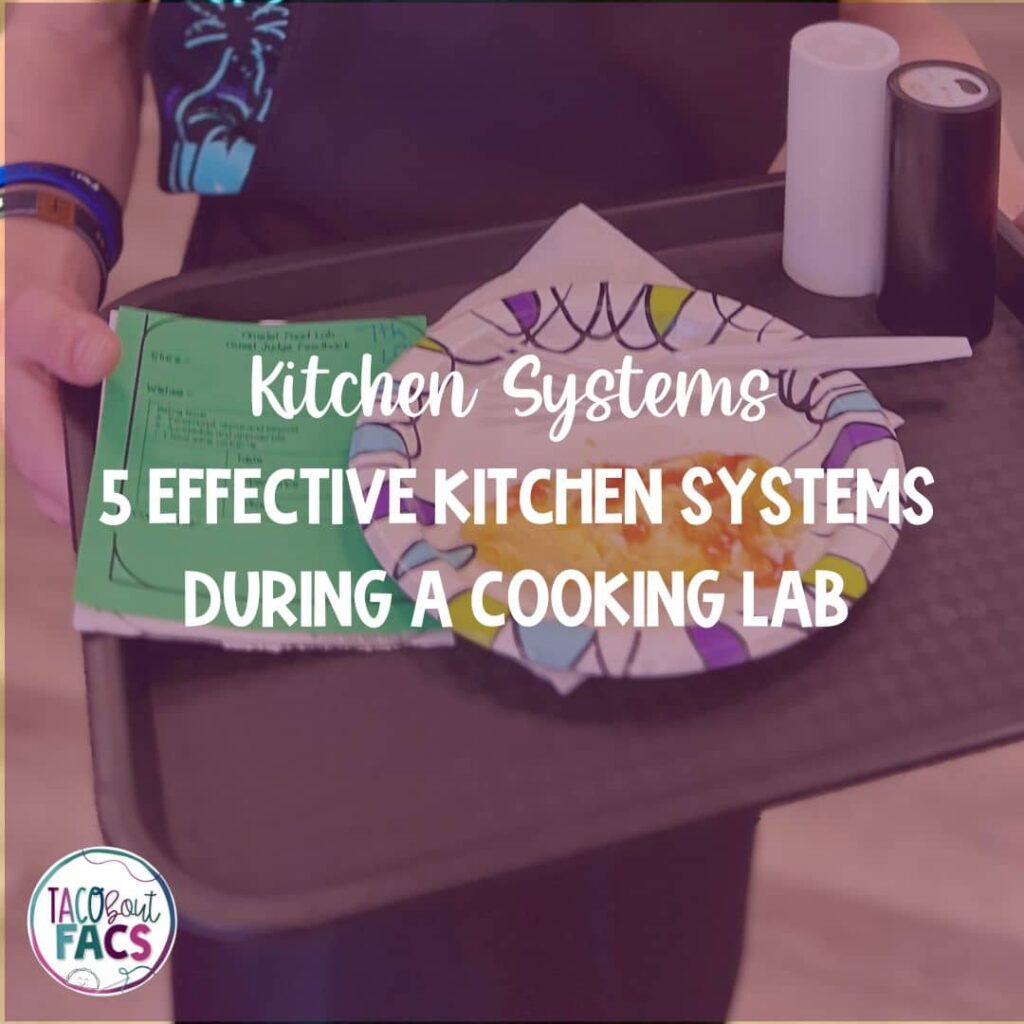Cooking lab days, you know, one of the main reasons our students sign up for FCS classes.
They are the days that can make you feel confident about your classroom management or make you question what full moon, severe weather, or solar flare is throwing your students’ self-control out the window.
Let’s be honest, even if you feel confident in classroom management, you can still adjust and re-adjust the sails, or classroom systems, to make sure your next lab is more successful.
Cooking lab days will not be successful without properly setting your students up for success. In case you missed you haven’t read about preparing for a cooking lab, you can read about it here.
Successfully setting the tone before the lab makes a world of difference on cooking lab days.
Teaching urgency
On any given day, I don’t allow the next hour in the classroom until invited in. This allows the previous hour to get out of the way and there is less chaos during passing period. The hour waiting to arrive makes a line along the wall and waits patiently. On cooking lab days, they are chomping at the bit to come in and drop their bags.
Once the tardy bell rings, I give a quick set of reminders- maybe it’s to turn up the oven temp 10 degrees, or not to put metal in the microwave *cough*1st hour*cough*, etc.
Students know my line after that is always “Hat, hairnet, hair tie, apron, grab your food lab plan, let’s go!” Usually, I have kids saying it with me.
Food lab days usually mean 2-3 kids out of 150 are tardy because they know we are in the kitchen as quickly as possible.
And because a clock, several printed bell schedules, and verbal reminders aren’t enough, I also have a digital workout clock that is set to countdown the time. If I forget to set it, I always have a student who reminds me. It’s usually within 1-2 minutes of the bell ringing and has been a surprisingly helpful way for students to see how much time is left in class.
Teaching urgency lets them know they don’t have time to think they look silly with a hair net. We don’t have time to waste 49 minutes when we are making food they enjoy.
Kitchen jobs
Kitchen jobs are the key for your intro classes. Until students prove otherwise, jobs help keep the world turning.
Along with teaching urgency, knowing your job and starting tasks is helpful to make sure students aren’t standing around. Who is spraying and wiping down the counters to begin? Who is getting supplies? Who is pulling out the necessary pots and pans?
I’m watching and assisting from afar, but if a group starts to bring out confidence and natural leaders who are working well together, it’s easy to let them adjust jobs as needed.
Along with kitchen jobs, is the job of dishes. Having the jobs spelled out ahead of time makes it easier for someone to begin doing dishes throughout the lab instead of waiting for the end.
With a 49-minute class, we don’t have time to wait until the end to start dishes.
Serving guest judges
Another way to improve kitchen systems is to get students thinking outside of themself.
Not every student loves zucchini pizza bites– or else they think they don’t until they try them. If you are lacking the student buy-in, it can make it harder to get them motivated to cook and clean.
This is where guest judges increase the student buy-in. Serving guest judges, in the words of my students is “fun, scary, favorite part, and they love the feedback”. If I’m holding a green slip of paper, my students know I have a judge’s feedback.
Guest judges have been trained to know they receive a green 1/4 piece of paper. They return the slips by the first thing the next morning. I use the feedback to help students reflect and grow.

It’s become a powerful piece to practice public speaking, serving skills, and overall confidence. Two students from each group are able to serve and the guest judge remains a secret until the food is plated and ready to walk out the door.
If you consider the number of labs and the number of kitchens completing the labs, there has been a relatively small number of poor feedback.
This has been a strong system for students to learn how to work together, serve staff with food allergies, and pay attention to details even if they aren’t interested in the food themself.
Consistency is key
Another way cooking lab days continue to be successful is consistency.
This almost seems like too simple, or elementary, but it works. Cabinets and drawers are labeled. I found it even more useful to label shelves inside the cabinet.
Why does it work? It takes the think time out of where to put clean equipment. Plus it makes it easier to find what they need when cooking.
Sure, things get misplaced, but it’s less likely to be misplaced.
Each kitchen has a kitchen timer. Timers should be returned to stuck to the microwave so we know where it is located. Clear, plastic recipe holders should be to the counter to the left of the oven.
Keeping this consistency helps students learn the routine and less likely to be wasting time looking for stuff.
Cleaning up
When kitchen systems are strong, I get to stand to the side and assist as needed.
This includes sweeping, mopping, and laundry. Make sure all parts of cleaning has a system. What does it look like and what does it sound like?
Don’t jump to conclusions- it’s not always rainbows and butterflies over here. I’ve had to resort to labeling my washer and dryer. As in which one is the washer and which one is the dryer. Bless.


I’ve also labeled the steps to use. Some students know and step right up. Others are more reluctant and haven’t done laundry before.
If I notice a repeated struggle, I realize the need for a label and learning. We are hear to teach life skills.
I’ll gladly teach skills about how to make the kitchen cleaner if my course brings in students who become eager to learn.
In fact, I rarely run laundry myself. Students volunteer to run a load when they notice the need more often than me asking someone to do laundry.
I also promise not to let any moms and dads know their child volunteers to steam mop or run a load of laundry if they’re behaving in the kitchen. It’s a win-win!
Fine tuning systems
I’ve come to realize you cannot have too many systems in your class. I am the facilitator and they carry the class, but that doesn’t work without systems.
My role is to empower and provide the tools to problem solve. I am not the problem-solver.
When I notice a problem, I have to be quick to reflect and find a way to lead them to a solution. And sometimes that is with visual reminders.
Fine tuning systems to set students up to be successful is worth the time it takes to think through your kitchen routines.

